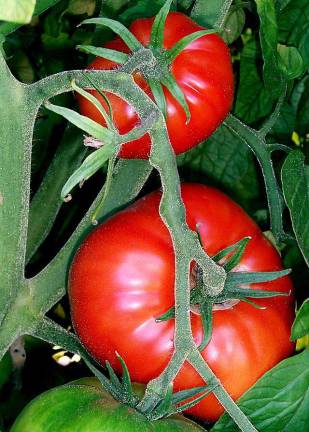Tomatoes Spread from New World to Europe Are Nutrition Stars Today
The tomato, first imported to Europe by Spanish Conquistadors, is a nutrition star paticularly of Spanish and Italian cuisine. Its loaded with vitamins B, C and E and respectable amounts of magnesium, phosphorous and potassium and antioxidants.

The tomato is so much a part of Italian and Spanish cuisine that you may be surprised to learn that it is actually a New World native, the “tomatle” or “xitomatle” that the Aztecs introduced to Spanish Conquistadors at Montezuma’s court,
Botanically speaking, the round red food they delivered was a fruit, defined as “a fleshy plant surrounding its seeds.“ On the other hand, USDA categorizes tomatoes, along with avocados, cucumbers, green peppers, zucchini, and butternut squash, as veggies, based on their plentiful nutrients and tart taste.
Either way, the tomato is a nutrition star. Start with its vitamins B, C and E. Add respectable amounts of major minerals magnesium, phosphorus, and potassium. Then note that what make tomatoes truly special is its status as our best source of the red pigment lycopene, a strong antioxidant that protects your body from damage due to compounds called free radicals which stress your organs and tissues.
According to Kathleen M. Zelman, Assistant Professor of Nutrition at St. Mary’s Dominican College, director of nutrition for WebMd, that’s a Big Deal.
Her list of lycopene’s good deeds starts with your blood vessels. Several studies suggest that lycopene is an anti-inflammatory that may keep your blood pressure at a pleasant level, reduce the amount of the “bad cholesterol” low density lipoproteins swimming in your arteries, and keep your blood from clotting when it shouldn’t. All of which, of course, reduces your risk of heart attack and stroke.
Moving on, lycopene appears to prevent or slow the formation of cataracts. Along with two other antioxidants, lutein and zeaxanthin, it also seems to reduce the loss of cells in the macula, the part of the retina that gives you clear vision looking right ahead. That means less risk of macular degeneration, the leading cause of blindness in older adults.
Now let’s talk teeth, a two-part tale. Part one: Lycopene fights gingivitis and periodontitis, two common causes of loose and then lost teeth. Part two: Because fresh tomatoes are seriously acidic, they may damage the enamel that keeps cavities at bay. Scrubbing with a toothbrush may worsen that, so WebMd’s easy solution is to wait at least half an hour after eating tomatoes to brush. Some animal studies and test-tube trials hint that lycopene may also be a mild analgesic, keep bones strong by slowing the loss of bone cells, and maybe even help maintain your memory as you age, but confirmation requires human testing.
Right now, there’s no official daily dose of lycopene, but the Mayo Clinic says to aim for 2-30 mg a day. That’s easy with the standard five servings of red/yellow/orange fruits and veggies such as sun-dried tomatoes (45.9 mg lycopene/3.5 ounces); canned tomatoes (2.7 mg/3.5 ounces), and fresh tomatoes (2.57 mg./3.5 ounces). Skip supplements though: Overdoses of lycopene, more likely from pills than from plants, may turn your skin orange.
Other than that, Tomaayto. Tomaahto. Terrific.
=====
Some animal studies and test-tube trials hint that lycopene may also be a mild analgesic, keep bones strong by slowing the loss of bone cells, and maybe even help maintain your memory as you age, but confirmation requires human testing.